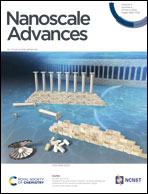Sieving nanometer enantiomers using bound states in the continuum from the metasurface†
Abstract
Enantioseparation of chiral molecules is an important aspect of life sciences, chemical syntheses, and physics. Yet, the prevailing chemical techniques are not effective. Recently, a few types of plasmonic apertures have been theoretically proposed to distinguish between chiral molecules that vary based on their handedness under circularly polarized illumination. Both analytic calculations and numerical simulation demonstrated that enantioselective optical sieving could be obtained at the nanoscale using a large chiral optical force based on plasmonic resonance enhanced near-field chiral gradients in the aperture. Nevertheless, scaling this scheme to chiral entities of a few nanometer size (i.e., proteins and DNA) faces formidable challenges owing to the fabrication limit of a deeply sub-nanometer aperture and the intense power levels needed for nanoscale trapping. In contrast, by extending the Friedrich–Wintgen theory of the bound states in the continuum (BIC) to photonics, one may explore another mechanism to obtain enantioselective separation of chiral nanoparticles using all-dielectric nanostructures. Here, we present a metasurface composed of an array of silicon (Si) nanodisks embedded with off-set holes, which supports a sharp high-quality (Q) magnetic dipolar (MD) resonance originating from a distortion of symmetry-protected BIC, so called quasi-BIC. We, for the very first time, show that such a quasi-BIC MD resonance can markedly improve the chiral lateral force on the paired enantiomers with linearly polarized illumination. This quasi-BIC MD resonance can enhance the chirality density gradient with alternating sign at each octant around the Si nanodisk, while exhibiting a small gradient for the electromagnetic (EM) density. This offers a chiral lateral force that is 1 order larger in magnitude compared to the non-chiral lateral forces on sub-2 nm chiral objects with a chirality parameter of ±0.01. Moreover, the quasi-BIC MD resonance can excite four pairs of diverse optical potential wells (−13kBT) that are distributed uniformly along the outer edge of the resonator, enabling a simultaneous separation of four paired enantiomers. Our proposed dielectric metasurface may move forward the techniques of enantioseparation and enantiopurification, taking a novel perspective to advanced all-optical enantiopure synthesis.



 Please wait while we load your content...
Please wait while we load your content...